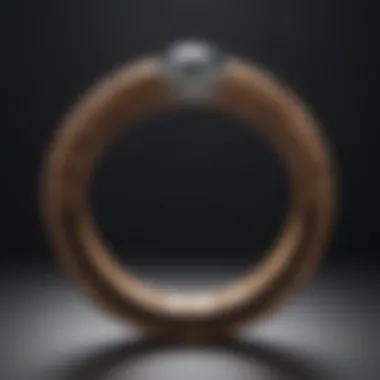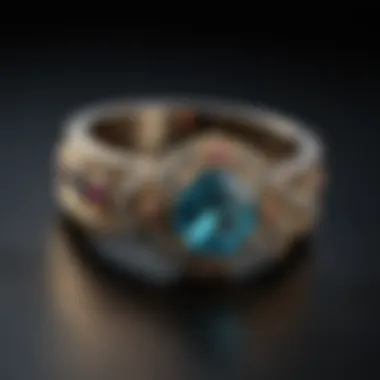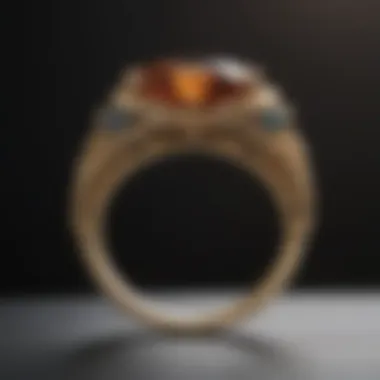Understanding Ring Sizes: The Importance of Internal Diameter


Intro
Understanding ring sizes is essential for choosing the right jewelry. The internal diameter plays a critical role in how a ring fits. A proper size ensures comfort and wearability, making it vital information for anyone purchasing rings.
This article will cover the internal diameter's impact on fit and comfort, methods for measuring rings, significance in buying jewelry, potential differences globally, and variations in material considerations. This comprehensive look intends to enlighten readers, whether they are buyers or designers, in selecting or creating rings that suit their needs.
Overview of Ring Sizes
When talking about ring sizes, the internal diameter is one of the main aspects one should consider. The internal diameter of a ring refers to the width across the inner circle of the ring. It directly correlates with how snugly the ring will fit over your finger.
Importance of Accurate Measurement
Accurate measurement is critical when determining ring size. A ring too tight can cause discomfort and pain, while a loose ring may fall off inadvertently. Factors such as knuckle size, finger shape, and temperature can also influence how a ring fits.
It’s advisable to get professional help for precise fitting. If that's not possible, there are methods one can use at home, including:
- Using a strip of paper to measure your finger's circumference
- Comparing with another ring that fits well
- Using a ring size chart available online
This understanding empowers individuals to make informed decisions, ensuring that they choose rings that fit perfectly.
“The right ring size can enhance both comfort and aesthetics, making the entire experience of wearing jewelry more enjoyable.”
Method of Measurement
Using correct methods for measuring ring sizes can determine internal diameter with accuracy. Measuring tape that is flexible can be wrapped around the finger; moreover, retaining the level of snugness you find comfortable.
Popular methods include:
- Ring sizer tool: This is a set of rings of different sizes you try on until the right one is found.
- Online ring size calculators: These often require you to input the circumference of your finger.
Understanding Differences Across Regions
Ring sizing standards differ across regions. In North America, the measurement follows a numerical gauge, whereas places like Japan and Asia use different systems. Knowing these differences is important, especially when purchases involve brands from other countries.
Accurate awareness of these factors not only aids personal understanding but ensures that others make wise decisions too when presentotional role in their buying decisions.
Culmination
Understanding internal diameter in ring sizing forms the vital core of successful jewelry selection. The nuances, from measurement techniques to regional standards, underscore that buying the right ring means paying attention to detail. Ultimately, wearing rings that not just fit but resonate with an individual's style creates enjoyable sentiments associatives with lovely pieces of jewelry.
Preface to Ring Sizes
Understanding ring sizes is critical for those invested in jewelry, whether as collectors, designers, or enthusiasts. The size of a ring determines its comfort, style, and suitability for various occasions. A well-fitting ring not only complements personal aesthetics but also ensures that the piece can be worn with ease. This article highlights internal diameter, the most vital factor regarding ring sizing.
Accurate measurement of internal diameter impacts how an entire piece functions on the finger. Without attention to this key measurement, buyers can face dissatisfaction due to discomfort or not being able to wear the jewelry at all. Furthermore, many people may not be aware that finger sizes are not static; they can vary due to factors such as time of day, temperature, and individual physiology.
Thus, this comprehensive exploration seeks to demystify ring sizes through tangible factors that influence them. Elements like personal preference, material selection, and cultural variances all contribute to the overall uncertainty in selecting the correct fit. Having a clear understanding of internal diameter will aid potential buyers in making informed choices and ensure that their purchases will not only look great but feel great, too.
The Importance of Internal Diameter
Internal diameter serves as the cornerstone of a perfect-fitting ring. It is not merely a number; rather it is an infrangible qualifier determining how well a ring can serve its purpose as an accessory or a symbol. Internal diameter is crucial as it provides insight into various possibilities for style and comfort.
"Accurate measurement of internal diameter is key to comfortable and stylish ring wear."
An appropriate internal diameter ensures that a ring remains secure on the finger. A substantial looseness can lead to the inadvertent slipping of the ring, increasing the risk of loss. Conversely, a ring that is too tight can impair circulation, leading to discomfort or even pain.
Understanding this measurement also helps in accommodating changes over time. Fingers can swell or reduce in size, making consistent re-evaluation necessary.
In summary, incorporating proper attention to internal diameter into the journey of ring selection is not simply a minor detail. Rather, it is a fundamental aspect embedded within the entire process of choosing the right piece of jewelry. Through careful consideration and understanding, one can achieve optimal satisfaction with their purchase.
Understanding Internal Diameter


Understanding the internal diameter is essential when discussing ring sizes. This measurement directly affects how a ring fits on a finger, making it crucial for comfort and overall satisfaction with a jewelry piece. Knowing the internal diameter helps avoid common sizing issues, ensuring that the intended recipient or wearer has a ring that feels well-suited to their needs. As jewelry is often worn daily, achieving a proper fit is important to prevent discomfort or potential loss; sizes that are too tight can cause issues like swelling, while sizes that are too loose may lead to the ring slipping off.
Defining Internal Diameter
The internal diameter of a ring refers simply to the measurement across the inside of the band. Understanding this concept can prevent many misunderstandings about fit. It is typically measured in millimeters. Each ring size corresponds to a set internal diameter; therefore, accurate sizing is vital for both buyers and jewelers alike. A reliable spanning unit, such as a millimeter, allows for standardization across various manufacturers, making purchases simpler. This value assists in determining how well the ring will align with the finger it is intended for.
Measurement Techniques for Internal Diameter
Determining the internal diameter involves a few different techniques, each with specific purposes and useful outcomes.
- Using a Caliper: The most accurate way to measure internal diameter is with a caliper, a tool known for precision. Place the caliper fingers on opposite inner edges of the ring and note the measurement.
- Measuring Rings That Fit: For a quick reference measurement, a fit ring is often utilized. By using a ruler, taking the inner diamater can be swiftly achieved. Take care to document the measurement accurately, as this improves order accuracy for additional copies or similar rings.
- Ring Size Charts: Utilizing ring size charts can also assist in understanding the correspondences between different measurement systems. These charts typically provide conversions that help make sense of different international sizing.
Accurately measuring internal diameter is the foundation of all personalized ring purchases, which can maximize wearability and satisfaction.
Understanding the internal diameter not only enlightens the reader about sizing metrics but also allows for informed decisions before engaging in a purchase or custom design. This focus lays a groundwork understanding about the intricate world of properly sized rings.
Factors Influencing Ring Sizing
Understanding how various factors affect ring sizing is crucial for selecting the right fit. This section highlights the intricacies involved and the benefits of considering them before purchasing or custom designing a ring. Accuracy in sizing not only enhances comfort but also ensures longevity in wear. Moreover, differences in finger shapes and materials can significantly influence how a ring feels on your hand. The interplay between these elements is noteworthy for anyone engaged in the jewelry process.
Finger Shape and Size Variability
Each set of fingers has unique characteristics. Some people have wider knuckles compared to their fingers, while others have long and slender fingers. These variations lead to differences in how rings fit. If a ring is too loose, it may spin or slide off. Conversely, a tight ring can cause discomfort or leave marks.
When measuring for a ring, considering finger shape is essential for the fit. A size that supports the broader knuckle but is snug enough for the rest of the finger can be perceived as perfect. Because fingers do not come in standardized forms, individuals must weigh both their personal experiences with fit and expert advice.
Here are important considerations for finger shape:
- Knuckle vs. Profile Size: Knuckles' standards might call for a size larger than that needed for finger width.
- Finger Swelling: Temperature changes and daily activities can affect finger size. Thus, a thorough assessment across conditions may be warranted.
Metal Type and Its Impact on Fit
Metal type is often overlooked, yet it plays a significant role in how a ring fits. Different materials have varying densities and stiffness, which can affect comfort. For instance, platinum and white gold offer entirely dissimilar feels despite a potential identical measured size. Platinum tends to be denser and heavier compared to gold and can result in a tighter sensation.
Here are several factors related to metal types:
- Temperature Conductivity: Some metals retain heat, causing fingerprints to swell around the ring's interior lead to an uncomfortable fit.
- Metal Allergies: Certain alloys in some metals, like nickel in white gold, can irritate the skin, causing swelling and making the ring feel tighter.
- Thickness and Designers' Choices: Unique design features, such as wider bands or integrated settings, can require slight adjustments in sizing based on bulkiness or movement on your finger for comfort.
By considering both finger shape and metal type, you can ultimately select a ring that feels comfortable as well as aesthetically pleasing. It also enhances your overall experience in wearing jewelry.
How to Measure Ring Size Accurately
Accurate ring sizing is essential for achieving the ideal fit and ensuring comfort. Even a slight discrepancy can affect the wearer's experience. Measuring ring size accurately might seem straightforward, yet various techniques offer different levels of precision. Understanding these methods helps consumers minimize errors when selecting or creating rings.
Using a Measuring Tape
One of the simplest ways to ascertain ring size is by utilizing a measuring tape. The advantages are notable; it ensures you can measure at home without the need for advanced tools. To use a measuring tape effectively:
- Position the Tape: Wrap the measuring tape around the finger where the ring will sit. Ensure it is snug but not constricting.
- Record the Measurement: Mark where the tape overlaps. The length in millimeters is your measurement.
- Refer to Size Charts: Compare your measurement with a reputable ring sizing chart. Most charts correlate the internal diameter directly to ring sizes.
Keep in mind to measure at the time of day when your fingers are at their average size, usually when you're neither too hot nor too cold.
Using a Ring Sizer
The use of a ring sizer presents another reliable method for accurate measurements. A ring sizer is a small tool, usually resembling a set of metal finger rings in various sizes. To use a ring sizer:
- Select the Right Tools: Obtain a plastic or metal ring sizer, typically available online.
- Slide the Sizers: Begin by sliding the sizers over the intended finger; stop when it fits snugly but comfortably.
- Identify the Size: Observe the size indicated on the ring sizer to find your accurate fit.
It is crucial to test multiple times, as averages might happen due to ring size variability. This method does nir require additional tools and often enhances user autonomy in the measuring process.
Professional Measurements at Jewelers


While self-measuring can offer insights into sizing, seeking professional measures from jewelers delivers high accuracy. Expert jewelers possess experience that allows them to gauge nuanced sizing specifics that others might easily overlook. Getting a professional measurement includes:
- Visit a Jeweler: Most jewelers will measure your ring size complimentary, creating access to professional input.
- Consider Finger Variability: Jewelers typically measure during optimal conditions, humidity and temperature—factors that directly affect finger size and, subsequently, ring size.
- Inspecting Different Styles: Experts can account for factors, like uri stone width and shape, which can alter fit. A clear conversation about intended design enhances this process.
In summary, accurate ring sizing can be accomplished through several methods. Each one primarily suffuses the necessity for versatility and adaptability in sizing strategies. Better accuracy protects against discomfort and unforeseen problems later post-purchase. Therefore, awareness of technique and honesty in measurements facilitates smarter, more satisfying decisions in ring selection.
Common Misconceptions About Ring Sizes
Understanding the nuances of ring sizing is essential for making informed decisions. There are several misconceptions regarding how ring sizes work. Addressing these misconceptions not only helps in accurate purchases but also ensures comfort and satisfaction when wearing rings.
Assuming Standard Sizes Fit Everyone
Many people believe that one standard ring size can accommodate everybody. This assumption is fundamentally flawed. Ring sizes are not one-size-fits-all, as individual finger shapes and sizes can vary significantly. Factors such as body temperature, hydration levels, or even the time of day can affect finger dimensions.
Consequently, a size that works for one person may be uncomfortable for another. Additionally, each jeweler may have slight variations in their sizing charts. It's crucial therefore to measure accurately. Readers should approach ring sizing as a highly personalized process. Considerations, when buying rings for yourself or as gifts, will help prevent disappointments later.
Underestimating Seasonal Size Changes
Another prevalent misconception is overlooking how seasons can affect ring size. People often do not consider that temperature shifts could influence their finger sizes. In warmer months, fingers typically swell due to heat and increased blood flow. Conversely, colder weather can lead to constriction of blood vessels, thus making fingers smaller.
This variability means that it is possible to outgrow a ring fit during a season. Those who frequently wear rings might find themselves adjusting their choices based on daily fluctuations. It's wise to keep in mind that seasonal variations are real.
Ensuring proper fit all year round requires cognizance of how seasonal changes might influence finger size.
Individuals should closely monitor how their rings feel as seasons change. There may be a need to have certain rings resized, especially if they have been unworn for a long period. Knowing these misconceptions allows wearers to enjoy their rings without discomfort.
Regional Variations in Ring Sizing
Understanding ring sizes requires acknowledging variability, especially when examining regional differences. These variations can significantly influence how rings are perceived, purchased, and personalized. Different regions utilize distinct sizing systems, which can lead to confusion for individuals shopping internationally or considering custom projects.
A key aspect of this discussion is the understanding of local sizing standards. Countries such as the United States, Europe, and Japan follow their unique measurement systems. This difference matters precisely to find a fit that aligns with specific aesthetic preferences and cultural norms surrounding jewelry. Hence, a comprehensive guide to these regional variations enhances the reader’s ability to navigate the complexities involved with ring purchasing, ensuring they achieve a comfortable and realistic fit.
Understanding International Ring Size Charts
International ring size charts are essential to grasping how various systems compare with one another. Most likely, a person in the United States uses standard numbers such as 5, 6, or 7, while someone in Europe may refer to sizes ranging from 50 to 58, and Japan employs an entirely different metric measurement. The reference point varies globally. Rapid globalization makes purchasing jewelry across borders more commonplace, further amplifying the necessity of recognizing these charts.
Here are some key pointers when consulting international ring size charts:
- Numerical Differences: Land in different regions applies numbers differently; thus, find the conversion from your local size to international standards.
- Measurement Units: Some charts display values based on internal diameters in millimeters. Without understanding that, one's search may mislead.
- Standardization Movements: Efforts are underway to adopt universal sizing conventions, yet as trends often languish at country borders, your wiring may still depict complexity.
Understanding various international ring size metrics %will lead you to %a suitable purchase, reducing returns and frustration.
Cultural Differences in Sizing Preferences
Cultural influences also affect sizing preferences in significant ways. Changing social norms, traditions, and even religion can shape how rings are accepted within each culture. For example, in countries where custom jewelry is revered, individuals might prefer tailored rings that accommodate specific tastes beyond simple size adjustments.
Cultural factors might include:
- Symbolic Meanings: Some cultures attach deep meanings to jewel's design and craftsmanship detail, influencing size choice drastically.
- Investment Perceptions: Countries with rising wealth observe recruitment of customer bases more inclined towards investment pieces rather than mere function-oriented manufacturing.
- Gender Norms: Gender expectations vary, meaning size preferences for men versus women can be quite disparate depending on regional climates and social mores.
Exploration into cultural customs around ring sizing aids individuals engaged in this sector to understand not only fitting correctlyamong regions but producing items esteemed by clients worldwide. Collaborating with a knowledgeable jeweler local to the customer's region will further enhance buying strategies and size considerations.
The Impact of Gemstones on Ring Design
Gemstones play a crucial role in the overall design of rings, influencing both visual appeal and practical considerations such as size and fit. Understanding how gemstones integrate with the ring design can help individuals about to purchase or design a ring make informed decisions. The choice of a gemstone affects not only its aesthetic value but also internal diameter requirements.
Human attraction to gemstones starts with their unique colors, radiance, and perceived value. While various gemstones exist, their specific properties introduce substantial nuances into ring design. For example, the size of the stone can affect the required size of the band slot as well as the internal diameter for optimal fit on the finger. A larger, heavier stone demands a broader band for support, potentially altering overall sizing needs.
When selecting a gemstone, consider the following factors:
- Gemstone Size: A large gemstone might also imply a need for a larger internal diameter. This ensures that the ring does not become uncomfortable when worn.
- Cut Quality: Certain cuts can sharp edges that should fit within the set band dimensions, affecting internal measurement. Cuts like emerald or asscher may require more specific settings to optimize comfort and fit.
- Setting Style: Different styles, such as prong or bezel setting, can make gemstone fittings vary in size. Understanding these styles helps determine the corresponding internal diameter.


By knowing what each gemstone contributes and the intricacies of design associated with them, one can appreciate how vital the gemstone selection is to overall comfort and aesthetics in ring design.
Setting Styles and Their Size Requirements
The choice of gemstone inevitably connects to the setting style used in ring design. Each setting has its own visual and structural characteristics that directly impact the ring's internal diameter and overall dimension. For instance, a halo setting surrounds the main gemstone with smaller stones, creating dramatic visual effects but requiring additional space.
Smaller rings can comfortably integrate lower settings that may affect internal measurements. When thinking about setting styles, remember:
- Prong Settings: Typically create a sense of openness. They can vary as the number of prongs changes, which means an understanding of your chosen stone's height is key to measuring ring size.
- Bezel Settings: Encircle the stone, providing a more secure fit, but also necessitating precise measurements as it directly influences how snug the ring will conjoin with the finger.
- Channel Settings: These allow for only a slim intermediary of gemstones before meeting the base. It is important to consider the added internal width to accommodate stone placement without sacrificing comfort. Whether selecting a contemporary crossover or traditional solitaire, consideration of the selected setting's effects on internal diameter leads to fits optimized for wearability and satisfaction.
Balancing Aesthetics with Comfort
Every jewelry collector and gemstone enthusiast understands the need for balance between aesthetics and comfort with ring design. The beauty of a gemstone is indeed crucial, yet it must complement the wearer's lifestyle and preferences, including how it structurally integrates with the fingers.
Aesthetics can be subjective, but consideration of the following contributes to comfort:
- Internal Diameter: This measurement must facilitate easy wear. When people select rings with prominent gemstones, it increases the potential for overwatch areas sticking out or uncomfortably resting against the skin. Ensuring adequate sizing leads to satisfactory adjustment during wear.
- Finger Shape and Size: Individual differences vary significantly from one person to another. Comfort should prioritize how much wiggle room the finger can allow within certain framing styles or stone sizes.
- Weather Effects: Seasonal changes might temporarily affect finger width, making accurately sizing before purchase pivotal. The rings must accommodate not just size, but also feelings of temperature fluctuation and changes in natural water retention.
- Stone Qualities: Unconsidered sharp edges and rough finishes on stones may lead to abrasions over time. Selecting gemstones that blend aesthetic appeal while focusing feedback ensures inner comfort doesn’t take a back seat.
Development in understanding that both comfort and aesthetics explore comprehensive possibilities in connection secures an enchanced experience for any gemstone enthusiast falling for the intricate design of rings.
Customization and Custom Rings
Customization of rings offers a profound way to express individuality and style. When discussing ring sizes, internal diameter plays a crucial role in ensuring that a customized piece fits perfectly. Therefore, understanding this aspect of customization aids both the wearer and the designer in making informed choices.
Bespoke Designs and Sizing Considerations
Bespoke design is more than just a trend; it reflects a growing appreciation for personalized jewelry experiences. When one decides to go the custom route, several sizing considerations become apparent. Notably, customized rings often incorporate unique gemstones or intricate settings necessitating specific internal diameters for comfort and aesthetics.
Designers must pay attention to the wearer's comfort level and lifestyle. For example, those who frequently engage in activities might prefer rings that are slightly larger to accommodate finger swelling rather than tighter fits. Through this understanding, the final product not only aligns with artistic vision but adverse hand movements and temperature variations.
A structured approach to designing bespoke rings includes:
- Individual Measurements: It's wise to record precise internal diameter measurements before proceeding visually with the ring design.
- Consideration for the Gemstone: The size and shape of the chosen gemstone can significantly affect the overall ring size. Larger stones may require a more generous internal diameter to prevent rocking on the finger.
- Style Preferences: Different styles deftly influence sizing. For instance, heavier bands often call for a slightly larger internal measurement, while lighter designs might have a tighter fit.
Working with Jewelers for Precision
Partnering with professional jewelers can significantly enhance results in sizing when creating custom rings. Skilled jewelers possess the expertise required to ensure the internal diameter aligns correctly with your unique specifications. Their experience permits them to suggest adjustments based on material properties, type of gemstones used, and intrinsic design elements.
Communication with the jeweler is paramount. Present your idea and expectations clearly, noting factors such as wearer lifestyle, any potential restrictions imposed by unique band designs, and personal aesthetics. Crucially, this will allow the jeweler to propose designs or materials suited for easy maneuverability and ultimate comfort.
Finally, trial runs on fitting samples are beneficial. Allowing for attempts at alternative sizes and designs on your finger helps secure the right fit. In doing this, a jeweler can provide recommendations that maintain both visual allure and function.
When customizing rings, blending creativity with diligence in sizing creates an outcome neither compromised by precision nor hability.
Understanding customization and internal diameter when designing rings facilitates a smooth journey from conception to completion, fundamentally improving wearability.
Closure: The Significance of Accurate Internal Diameter
Understanding the significance of accurate internal diameter serves as a crucial element in selecting the right ring. Internal diameter directly affects how the ring fits on a finger, influencing comfort and overall wearability. A precise measurement can prevent discomfort or even possible loss of the ring, as improperly sized rings may slip off or feel too tight. Choosing the correct internal diameter ensures the ring remains in place while providing a level of comfort adequate for daily wear or special occasions.
A clear grasp of internal diameter also demonstrates knowledge when purchasing or designing jewelry. It can indicate to vendors and jewelers that the buyer possesses awareness of how sizing must correspond with design considerations, material differences, and personal preferences. As articulated throughout this article, biased assumptions regarding size should always give way to personalized measurements, particularly with the unique characteristics of each individual's finger shape.
Accurate internal diameter not only applies to new rings but also extends to existing pieces. If one gains weight, loses weight, or experiences changes due to seasonal variables, a reevaluation of ring size for comfort remains relevant. A carefully chosen internal diameter can facilitate true personal expression while maintaining comfort over time.
"Every ring deserves to shine as it was meant, which begins and ends with the right fit."
In enhancing one’s understanding about fitting rings, the importance of internal diameter emerges prominently. It make significant exchanges between style and comfort feasible, enabling both clarity and satisfaction in purchasing decisions.
Summary of Key Points
- Accurate internal diameter significantly influences the wearability and comfort of every ring.
- Precise measurements reduce chesiness and prevent misunderstandings with jewelers.
- Understanding personal changes expand the relevance of regular assessment of ring size.
- Knowledge about sizing can direct buyers and enthusiasts alike to a better jewelry purchasing experience.
Final Thoughts on Ring Sizing
In the journey of selecting jewelry, internal diameter frequently stands as an unsung hero in the discourse on fit. Recognizing its pivotal role factors into every aspect of ring sizing from the aesthetic appeal to user comfort. As daggers opinion on designs unfurl, jewelers face points of collisions without accurate observations on internal measurements. Combine this understanding with the observation behaviors across materials and regional preferences. This knowledge brings nuanced perspectives into the ring availability and also emphasizes considering personalized measurements.
Ultimately, the act of sizing a ring casts a spotlight before the populous estimates revolving around standard sizes that may not justify the full spectrum of individual variability. To 破解 a genuine jewelry selection experience requires interest, research, and care not merely with respect to artistry but practicality as well. Conversations about gemstones and designs gain clarity in the light of precise internal diameter insights.







